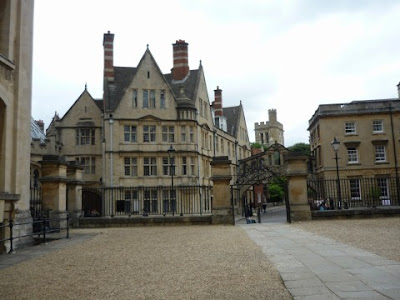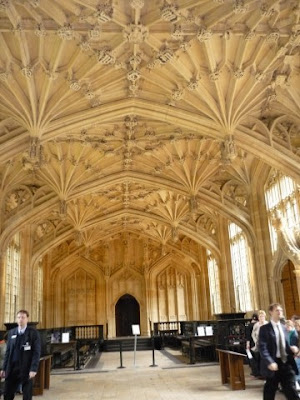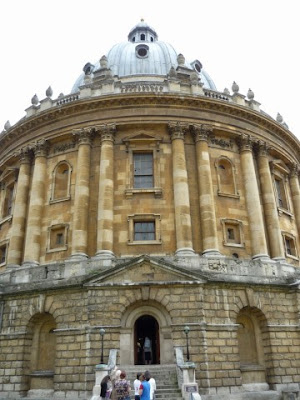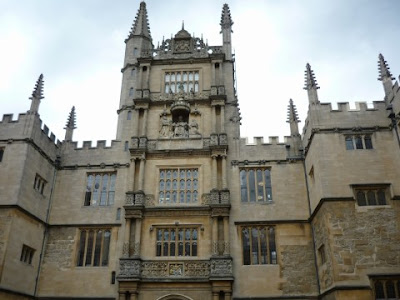
I feel as if I should start off with a grand statement because the Bodleian Library, it's like The Big One. The one I've heard most about from my professors, quoted in movies and film, and it's at Oxford University, for heaven's sake. The stakes are set sky high.
But I must cave into the pressure. I have no words, none besides, the Bodleian is all that -- if only I had a good idea as to where I was at any given time during my tour. To put it not very eloquently: the Bodleian Library is a big place. Our librarian/docent for the day is one Mr. Cross. He looks to be of a certain age, but let me tell you, he could probably take me in a foot race. In his three-piece suit, even. Part of the reason is that he's climbing through this maze called the Bodleian day in and day out.

We start off level enough, though. As we make our journey just inside the reading room, Mr. Cross enlightens us further on the history of the Duke Humfrey's Library, the main research library for manuscripts and early printing. (It is in fact the oldest reading room within the greater Bodleian library complex, and according to the official website: "the principal reading room for those studying Medieval and early-Modern manuscripts and Papyri, pre-1641, special and rare book collections, and codicological, bibliographical and local history.") I am pretty impressed on sight and smell alone (old books, they kill me -- in a good way).
The Duke, as the library is named after, donated his collection of 281 manuscripts and classical texts in the middle 1400s; such as large gift called for a greater space to house them, and work began to construct the Divinity School. It opened... some time later, as most university-funded projects do. It should also be said that Oxford University at this time was not a school with deep pockets in terms of money; the Reformation and the creation of the Church of England split the country in half religiously, politically, and with these drastic changes, the university suffered both in its prestige and actual educational capacity. Anything papal was in the midst of being destroyed, and the Duke Humfrey's library, having such early promise, by 1450 was nearly empty. The library had to resort to various means for funds, such as the selling of its property -- desks, chairs, and the like. Still, these sorts of measures could hardly have raised enough revenue to maintain let alone develop their library collections.
Enter Sir Thomas Bodley in the late 1500s: a rich and educated gentleman, Bodley was more to the point, a philanthropist. He donated money to restore the old library, as well as books from his own collection and other donors -- 2,500 in total. Samples of the books still exist today, their pages made of cloth or rags.

The first printed catalog came out in 1605, the contents of each bookcase written on a notice board; and looking at the books themselves, lining the shelves 400 years later, it's curious to wonder how much, or how little has changed. A famous story, one that Mr. Cross tells us now, concerns the King at the time, Charles I. Duke Humfrey's library, among others at the Bodleian, was not a lending library -- a tradition that persists to this day. Charles I, on a visit to the university, wished for little bedtime reading and sent someone to fetch him a book from the library. Unfortunately enough for him, being King of England did not curry him any favor with the university librarians, and the rules applied to him as well. (Librarians: tough cookies to crack.)
For centuries, the Bodleian library was a chained library, in fact; storage was backwards, the book spines facing the wall (the only way to attach chains to the books). The beginning of the 19th century allowed for the chains to be taken off, and the books righted spine-wise. Today there are two stories of reading rooms going around, forming a quadrangle. And below, there are seven stories sweeping downwards of book and manuscript storage.
Which leads us to our present predicament, following/chasing after Mr. Cross into the bowels of the Bodleian Library. It's like Willy Wonka's chocolate factory for librarians, passages going here and there, machines whirring, library assistants blinking curiously as we pass -- and of course books, millions of books. To access any of Bodleian's materials, patrons use request forms, which are sent and put through tubes, where those librarians and library assistants below go on a search to retrive them, sending the selected items up on a conveyor belt. (Of course, for access to rarer sources, readers need to put up good reasons and recommendations.) It's pretty freaking neat.
We ask about digitization in terms of promoting access, and work is being done (although, to compare perhaps unfairly, not nearly to the extent as in the U.S.). What to keep, what to reformat, what type of formatting -- these are all questions which pertain to libraries, whichever the specialization. For the Bodleian Library, since 1610 they have been in negotiations with legal guilds, and anything published by the guilds is given free of charge to the library -- in addition to a number of other titles selected. Curators then have one week to sort through the incoming materials, deciding whether to weed (British terminology!), keep, distribute to other libraries, and so forth. Needless to say, it's a huge responsibility. How do they begin to predict what will have literary worth come ten, twenty, hundreds of years from now? A blunder that keeps librarians humble here concerns perhaps the greatest playwright of all, one William Shakespeare. The Bodleian had in its possession a copy of the first folio (1632) and for whatever reason resolved that it was not worth saving. More than that, it was sold for a mere £24. (Amazing. I can only hope to be at such a book sale one day.)
It's a sobering thought, and easier to say in retrospect: how could this happen? But these things do, and we're not perfect in practice. The Bodleian isn't the British Library, mind, preserving all materials in the country, but its aspirations are not small by any means. While it isn't possible to predict the next Shakespeare (if any such comparison can be made), the Bodleian, being one of the most esteemed libraries in the world, has come far these past 400 hundred years -- with luck and perseverance, but never by accident.

Resources:
The Bodleian Library homepage
Images courtesy of Dr. Teresa Welsh
1 comment:
Emma,
I love that you have described the tour of the Bodleian as a tour of Willy Wonka's factory for librarians...seriously, because that is exactly what it felt like. Man, that was a freakin' awesome tour!
Elizabeth
Post a Comment